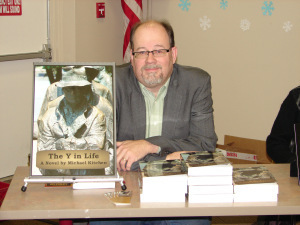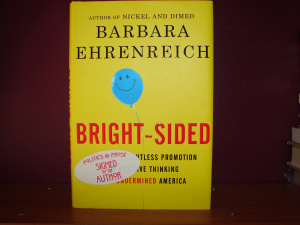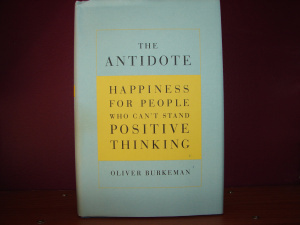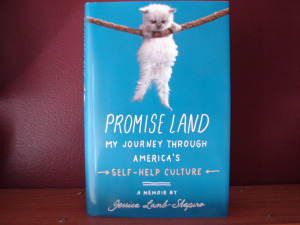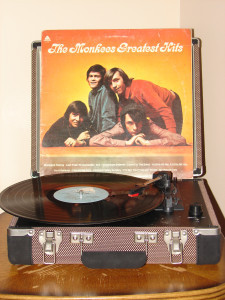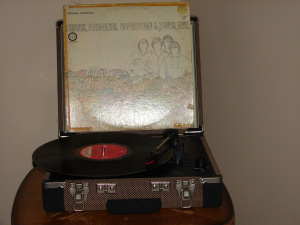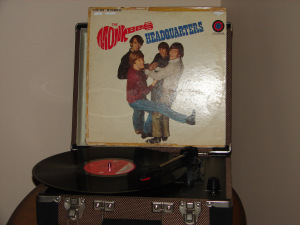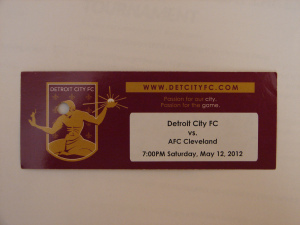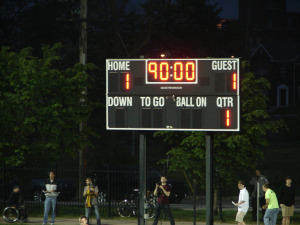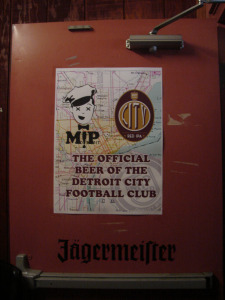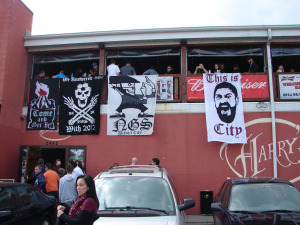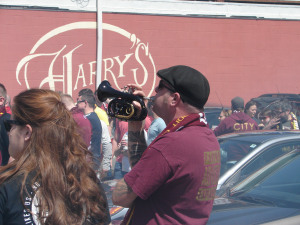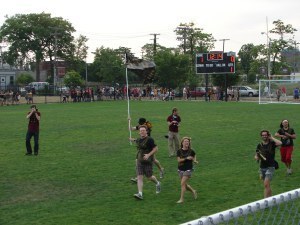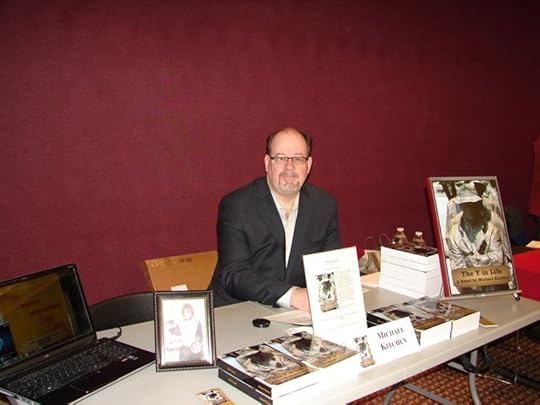Michael Kitchen's Blog, page 24
March 24, 2015
Upcoming events in Plymouth and Eastpointe – Saturday March 28 and Sunday, March 29, 2015
This Saturday, March 28, 2015, I, and over twenty authors, will be at the Plymouth District Library Local Author Fair.
Plymouth District Library
223 South Main
Plymouth, MI�� 48170
1PM – 3PM
MORE INFO HERE
Then, on Sunday, March 29, 2015, the East Detroit Historical Society is holding a Meet the Author event at the Halfway Schoolhouse.�� Macomb County authors include Cherie and Bob Allen, Alan Dean Naldrett, and Eastpointe Mayor Suzanne Pixley.
East Detroit Historical Society
Halfway Schoolhouse
15500 Nine Mile Road
Eastpointe, MI, 48021
3PM – 5PM
MORE INFO HERE

March 19, 2015
Book Review: A critical look at positive thinking
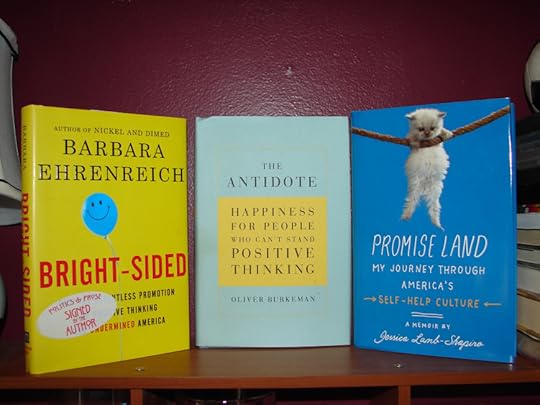 Serial, a 1980 comedy, puts regular guy Harvey Holroyd (Martin Mull) in a community of New Age philosophy, cults, and sexual freedom in Marin County, California, that tears at the fabric of his family.�� His wife, Kate, (Tuesday Weld), participates in a women’s consciousness raising group that is only too happy to point out Harvey’s flaws, while his rebellious teenage daughter, Joanie (Jennifer McAllister) becomes frustrated that Harvey suppresses her rights, and interferes with her peer-group dynamic, her socialization, her individuation and the father-daughter interface, that she flees to join a cult.�� Most of Harvey and Kate’s friends are seeing therapist Dr. Leonard Miller (Peter Bonerz) who is medicating them all, including himself, but not Harvey.�� Having seen this movie again recently on DVD, I laughed at its satire of the self-help industry and cult of optimism that has oozed into our society more significantly in recent years.�� The movie does takes pot shots at environmentalism, feminism, vegetarianism, and homosexuality, and one scene is set at an orgy that Harvey’s secretary talks him into attending.�� If sarcasm and satire isn’t your thing, this movie isn’t for you.
Serial, a 1980 comedy, puts regular guy Harvey Holroyd (Martin Mull) in a community of New Age philosophy, cults, and sexual freedom in Marin County, California, that tears at the fabric of his family.�� His wife, Kate, (Tuesday Weld), participates in a women’s consciousness raising group that is only too happy to point out Harvey’s flaws, while his rebellious teenage daughter, Joanie (Jennifer McAllister) becomes frustrated that Harvey suppresses her rights, and interferes with her peer-group dynamic, her socialization, her individuation and the father-daughter interface, that she flees to join a cult.�� Most of Harvey and Kate’s friends are seeing therapist Dr. Leonard Miller (Peter Bonerz) who is medicating them all, including himself, but not Harvey.�� Having seen this movie again recently on DVD, I laughed at its satire of the self-help industry and cult of optimism that has oozed into our society more significantly in recent years.�� The movie does takes pot shots at environmentalism, feminism, vegetarianism, and homosexuality, and one scene is set at an orgy that Harvey’s secretary talks him into attending.�� If sarcasm and satire isn’t your thing, this movie isn’t for you.
And, if you’re one who is guided by a secret, who believes unlimited power comes from pure optimism, who affirms that you will grow rich by thinking it, these are probably not the books for you.�� For these titles critically examine the world of self-help and the cult of positive thinking.�� If you’re like me who drank the frothy punch promising happiness and felt a bit woozy, as if the magic elixir is nothing more than sugar-coated tap water sold for champagne prices, these books shed light on why that is.
The three books above: ��Bright-Sided:�� How the Relentless Promotion of Positive Thinking Has Undermined America by Barbara Ehrenreich (Metropolitan Books, 2009), The Antidote: Happiness for People Who Can’t Stand Positive Thinking by Oliver Burkeman (Faber & Faber, Inc. 2012), and Promise Land: My Journey Through America’s Self-Help Culture by Jessica Lamb-Shapiro (Simon & Schuster, 2014) are three different approaches to critically examining the positive thinking industry/cult.
By way of full disclosure, I was immersed in this world for about six or seven years, through a New Thought church that I attended in the 1990’s.�� Prior to my discovery of this church, it had a larger-than-life founder/figurehead who had died – or made his transition, as was the parlance of the community, after all, ‘died’ is such a negative term – a couple years prior.�� Noted inspirational speakers such as Wayne Dyer, Les Brown, Louise Hay, and Og Mandino frequently appeared for a Sunday service, a Wednesday night program, or a Saturday seminar.�� The church underwent a shift when Marianne Williamson was named the church’s spiritual leader.�� The selfish interests of manifesting individual prosperity shifted to a liberal, go-beyond-the-walls-of-the-church approach, changing the dynamics of the congregation.�� It sent the “spirituality is me” entrepreneurials fleeing, and the more liberal, “beloved community” oriented seekers flocking.�� Conflicts between the Board of Directors (who hired her) and Ms. Williamson became too much of a distraction and I left when I discovered a Zen Buddhist Temple in Detroit – something I had been seeking since the late 1980’s.�� I met some wonderful people there and cannot say that I did not learn anything from my experience.
Barbara Ehrenreich entered the positive-thinking community after having been diagnosed with breast cancer.�� As she entered “the pink ribbon culture,” she encountered the phenomenon that inspired the writing of Bright-Sided.
As an experiment, I posted a statement on the Konen.org message board, under the subject line “Angry,” briefly listing my complaints about the debilitating effects of chemotherapy, recalcitrant insurance companies, environmental carcinogens, and most daringly, “sappy pink ribbons.”�� I received a few words of encouragement in my fight with the insurance company, which had taken the position that my biopsy was a kind of optional indulgence, but mostly a chorus of rebukes.�� “Suzy” wrote to tell me “I really dislike saying you have a bad attitude towards all of this but you do, and it’s not going to help you in the least”�� “Mary” was a bit more tolerant, writing, “Barb, at this time in your life, it’s so important to put all your energies toward a peaceful, if not happy, existence.�� Cancer is a rotten thing to have happen and there are no answers for any of us as to why.�� But to live your life, whether you have one more year or 51, in anger and bitterness is such a waste…I hope you can find some peace.”
Bright-Sided, page 32.
As she concludes the first chapter, Ehrenreich felt the same as I did from my experience at the church.�� “Breast cancer, I can now report, did not make me prettier or stronger, more feminine or spiritual.�� What it gave me, if you want to call this a ‘gift,’ was a very personal, agonizing encounter with an ideological force in American culture that I had not been aware of before – one that encourages us to deny reality, submit cheerfully to misfortune, and blame only ourselves for our fate.”�� (Page 43-44).
Ehrenreich researches and exposes the history of this ideological force, how it infiltrated the business culture, and posits how it crashed the economy.�� After reading the 206 pages of this book my neck was sore from all the nodding in agreement with Ms. Ehrenreich.
Where Barbara Ehrenreich revealed the harmful societal effects of positive thinking, Oliver Burkeman gives us The Antidote.�� Burkeman starts us off in San Antonio, Texas.�� In the professional basketball team’s stadium,�� Burkeman takes us inside a popular business motivational seminar – Get Motivated!�� He starts with self-help guru, author of over thirty-five books on positive thinking, and founding pastor of the largest church in the United States constructed out of glass, Dr. Robert H. Shuller.�� The octogenarian is hyping the crowd by claiming to reveal the secret to happiness.�� What does this sage offer?�� “Cut…the word ‘impossible’ out of your life.�� Cut it out!�� Cut it out forever!”�� (The Antidote, pg. 2).�� Burkeman offers a different path.
This book is the record of a journey through the world of the ‘backwards law,’ and of the people, living and dead, who have followed the negative path to happiness.�� My travels took me to the remote woodlands of Massachusetts, where I spent a week on a silent meditation retreat; to Mexico, where death is not shunned but celebrated; and to the desperately impoverished slums outside Nairobi, where insecurity is the unignorable reality of every day life.�� I met modern-day Stoics, specialists in the art of failure, professional pessimists, and other advocates of the power of negative thinking, many of whom proved surprisingly jolly.�� But I began in San Antonio because I wanted to experience the cult of optimism at its most extreme.�� (Pg. 10-11).
Burkeman covers Buddhism in the third chapter “The Storm Before the Calm: A Buddhist Guide to Not Thinking Positively.”�� I never considered Buddhism as ‘negative thinking.’�� Burkeman guides us through a brief history of Zen and meditation in America, arriving at American Zen Buddhist and psychiatrist Barry Magid’s book, Ending the Pursuit of Happiness who argued against the use of meditation as tool to make yourself better or happier.�� “The point, instead, was to learn how to stop trying to fix things, to stop being so preoccupied with trying to control one’s experience of the world, to give up trying to replace unpleasant thoughts and emotions with more pleasant ones, and to see that, through dropping the ‘pursuit of happiness,’ a more profound peace might result.”�� (pg 54-55).�� Burkeman then undertook a week-long retreat at the Insight Meditation Society in central Massachusetts.�� Almost ten hours of the sixteen hour days were meditation – either sitting or walking.�� He recounts his experience during the retreat, settling in and enjoying meditation by the end of the fourth day.�� But then, it hit the fan.
Without my noticing the precise moment of transition, the silence of the meditation hall became a combination of courtroom and torture chamber.�� For hours, I was attacked by barrages of negative thoughts and their associated emotions – anxious ones, guilty ones, worried ones, hostile, bored, impatient and even terrified ones – as if they had all been gathering just out of sight, for years, waiting for this moment to pounce.�� Above all, they were self-critical.�� I was suddenly aware – and somehow all at once – of countless occasions in my life on which I had behaved badly towards other people; my parents, my sister, friends, girlfriends, or colleagues…they filled me with sorrow…The sorrow that accompanied these realisations, from a Buddhist point of view, is a good thing; it is the fertile soil in which compassion can take root.�� (Pg. 71-72).
Burkeman contends that the Buddhist’s practice is a negative approach to happiness because of its radical perspective that “it is rarely wise to struggle to change the weather.” (Pg. 73).
One chapter critically denounces goal-setting, another argues the benefits of insecurity and embracing your failures; and another on death as a way of life.�� To sum up Burkeman’s “negative” approach to life would be that one should not pursue happiness as a goal to achieve.�� Instead, happiness is found by living in awe, now.
Jessica�� Lamb-Shapiro’s observation of the self-help/positive thinking world is different from Ehrenreich and Burkeman.�� She traveled with her father, a child psychologist and parenting author, and participated in the demonstration and selling of the products he promoted, since the age of six.�� In this memoir, Lamb-Shapiro relates her experiences within the self-help industry.�� She opens our eyes to the facade of Mark Victor-Hansen’s uber-expensive seminars (which her father received a full refund for), witnessing attendee’s blind confidence in their guru’s profoundly ludicrous schemes.�� She criticizes self-help books The Rules and The Secret, and how “experts” in this industry more often than not fit the Mark Twain definition of an expert – “an ordinary fellow from another town.”�� The chapters on addressing fear and grief – as Lamb-Shaprio confronts her fear of flying and the grief of losing her mother under unknown circumstances when Lamb-Shapiro was an infant – demonstrate some of the positives she experienced.
Unlike Ehrenreich and Burkeman who dissect the cult of optimism, Lamb-Shapiro’s personal journey reveals the positives and negatives of the self-help industry.�� I agree with her analysis that the blind faith of the followers holds massive potential for abuse.�� There are no checks and balances to these advisers.�� And, like most cults, their systems discourage interaction with other points of view.�� I experienced this firsthand.�� I still had contact with a couple of friends from the New Thought church as I questioned it and after I left it, and they fled from me like I had the plague.�� One in particular seemed to have taken a hostile attitude toward me.�� Lamb-Shapiro, like Ehrengraf and Burkeman, echo my experience of the cult of optimism, which reinforces opportunity for the individual over responsibility to the community.�� “At what point does looking out for number-one stop being a wholesome American value and start making you an asshole?” (Promise Land Pg. 207).
Obviously, everyone has to find what works for them, and if the culture of self-help and positive thinking works for you, that’s fantastic.�� I once immersed myself into this world of positive-thinking.�� But enough of its unhealthy water filled my lungs to the point where I had to flee from it for the real world in order to survive.�� These three books have become favorites of mine for detailing and exposing what I was feeling those six or seven years.�� Unfortunately, because corporate interests have found positive thinking to be beneficial to stifling dissension within the workplace, isolating the employee, and playing to his or her personal greed, so many more people will suffer.�� And some may explode, like Harvey Holroyd who expressed true feelings of grief at Sam’s (Bill Macy) funeral, (performed as a Native American ritual which Sam would have hated) and was tranquilized by Leonard.�� After reviving, Stokeley (Anthony Battaglia) provides Harvey with insight, like Ehrenreich, Burkeman, and Lamb-Shapiro do in their books.

March 4, 2015
Vinyl memories #4 – The Monkees
Growing up in the 1970’s I listened to CKLW -800AM out of Windsor, Ontario as my source of music.�� Some of my favorite songs at the time were Terry Jacks’ “Seasons in the Sun,” Lobo’s “Me and You and a Dog Named Boo,” Three Dog Night’s “Joy to the World” and Don McLean’s “American Pie.”�� But I had no favorite band or artist worth wanting an album from.�� Terry Jacks came the closest because I also liked his song “Christina.”
And then I saw their show.
On the UHF dial of the television was WKBD-TV Channel 50.�� During the after-school and dinner time hours, they aired shows from the past in syndication.�� Lost in Space.�� Batman.�� Gilligan’s Island.�� The Flintstones.�� The Addams Family.
And The Monkees.
The show was fun, but it was the music that hooked me.�� The Monkees Greatest Hits album above was, I believe, the first album I owned from a band.�� I know this is blasphemy to many music lovers out there, but I connected more to Davy, Mike, Micky and Peter than I did to John, Paul, George and Ringo.�� Yeah, I was not a very deep kid.�� Perhaps it was generational for me.�� The older kids I knew leaned toward the Beatles, but the Monkees reruns came on during my formative years.
They were not a band formed by the members, but by producers in Hollywood.�� The first season of shows generated the more popular Monkee’s hits.
It was the second season, where the boys – under Nesmith’s and Tork’s pressure – were able to have more creative influence on the music.�� They pushed away from having to wear uniform clothing during performances to a more individualized expression of attire.
As I am writing this, one of my favorite albums, Pisces, Aquarius, Capricorn & Jones Ltd. is playing in the background.
Side One:
Salesman
She Hangs Out
The Door Into Summer
Love Is Only Sleeping
Cuddly Toy
Words
Side Two
Hard to Believe
What Am I Doing Hangin’ Round
Peter Percival Patterson’s Pet Pig Porky
Pleasant Valley Sunday
Daily Nightly
Don’t Call On Me
Star Collector
The Monkee’s Headquarters, included what I considered the band’s best selections:
Side One
You Told Me
I’ll Spend My Life With You
Forget That Girl
Band 6
You Just May Be The One
Shades of Gray
I Can’t Get Her Off My Mind
Side Two
For Pete’s Sake
Mr. Webster
Sunny Girlfriend
Zilch
No Time
Early Morning Blues and Greens
Randy Scouse Git
I did not have these records at the time.�� The only Monkees’ album I had was the greatest hits.�� But I wouldn’t be denied Monkees music.�� I would take my portable cassette tape recorder, put in a tape, placed it on the floor in front of the television set, and watched the show, poised to begin recording when a song began.�� Primitive, yes.�� Unlike burning a CD, the tape would have the character of the background sounds, such as mom washing dishes or someone coughing in the room.�� And any sound effects in the show that occurred during the music also came through.
Something clicked in my mind with The Monkees, and still continues to this day.�� I best relate to music with an image or tangible experience.�� For quite a spell I was a fan of movie soundtracks.�� I’ve heard it said that The Monkees were the pioneers of the music video, which holds some truth for me.�� When MTV came on the scene, it was the music videos that attracted me to the music and bands I liked.�� In the 1980’s, I discovered that after The Monkees disbanded, Michael Nesmith continued to combine music and video in his movie, Elephant Parts.
In the 1980’s, Dolenz, Jones and Tork went on tour together.�� They came to Pine Knob that summer, and it was the third concert I ever attended (you’ll have to wait until my next vinyl memory to learn the first two).�� To this day I still enjoy this quartet and their songs.�� We lost Davy Jones on February 29, 2012, and the remaining members toured recently to sold out venues.
I recently saw on Facebook a petition for The Monkees to be inducted into the Rock and Roll Hall of Fame.�� My feeling is that if The Monkees aren’t in it, it’s not a Rock and Roll Hall of Fame. To this day, I’m still a believer in the music of The Monkees.
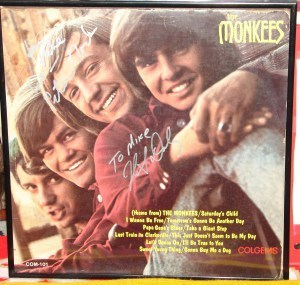
The first Monkee’s album signed by Tork and Dolenz.

February 28, 2015
The newcomer’s introductory guide to attending a Detroit City FC match
Those of us who are passionate about our city, and passionate about our soccer, who will sing for you, City, who is City Til We Die and will be buried in rouge and gold, are eager for the 2015 season of Detroit City Football Club soccer at Cass Tech Stadium (Estadia Cass Techia) to begin.
But you’re new.�� You haven’t tasted City ale, abused your lungs with chanting, singing, and smoke, and you wonder what all the commotion is about.�� Here’s a little primer to prepare you for the few hours of outrageous fun that is a Detroit City FC ‘Le Rouge’ soccer match.
A Little DCFC History
Detroit City FC, known as Le Rouge, play in the National Premier Soccer League, a fourth-tier professional league.�� The players on the team are unpaid current and past college players.�� On May 12, 2012, Detroit City FC took to the its home field for the first time against AFC Cleveland.�� Drawing 1,072 fans at its inaugural game exceeded team ownership’s expectations.�� The result was a 1-1 draw.�� (click on photos to enlarge).
Home is Cass Tech Stadium on the campus of Detroit’s Cass Tech High School.�� The Detroit skyline provides a scenic background to the beautiful game played on the pitch.

 The 2012 Season saw Le Rouge finish third in the Midwest-Great Lakes Conference with a 5-5-3 (Wins-Draws-Losses) record.�� Buzz was created and the team averaged almost 1,300 fans per game, with it’s largest crowd of 1,743 attending the June 23rd match against AFC Cleveland.
The 2012 Season saw Le Rouge finish third in the Midwest-Great Lakes Conference with a 5-5-3 (Wins-Draws-Losses) record.�� Buzz was created and the team averaged almost 1,300 fans per game, with it’s largest crowd of 1,743 attending the June 23rd match against AFC Cleveland.
In 2013, Le Rouge finished top of the Great Lakes Conference with 11 wins, 1 draw, and 0 losses.�� The fan base continued to grow, averaging about 1,485 per game.�� As conference winners, Detroit hosted the Great Lakes Tournament playoffs, where Le Rouge defeated AFC Cleveland 3-1 before a crowd of 2,634.�� However, the next day, they fell to the Erie Admirals, 4-1 before 2,184 fans.
2014 was another phenomenal season.�� With their first place finish they were granted entry in the U.S. Open Cup – the oldest professional soccer tournament in the United States.�� On May 7, 2014, DCFC hosted RWB Adria at Livonia Stevenson High School, battling the Chicago-based team from the Great Lakes Premiere League to a 2-2 draw.�� Unfortunately, they fell in penalty kicks 3-1.�� The regular season record of 8-3-3 put them one point out of first place.�� However, the DCFC craze multiplied.�� Every match attendance exceeded 2,000 fans, including a couple of sellouts.�� The final match of the regular season against the Fort Pitt Regiment brought in 3,398 fans, plus hundreds turned away, having to watch on the outskirts because of the packed stadium.
2015 – Getting in
This year, the season begins with two preseason matches – one on April 18th at Hurley Field in Berkley, the other at Cass Tech on May 9th.�� The regular season begins on May 15th.
If you want to get into a game this year, it’s going to be a little more difficult.�� The team’s popularity has exploded.�� You’re going to want one of these:�� A Detroit City FC Season Ticket. ���� 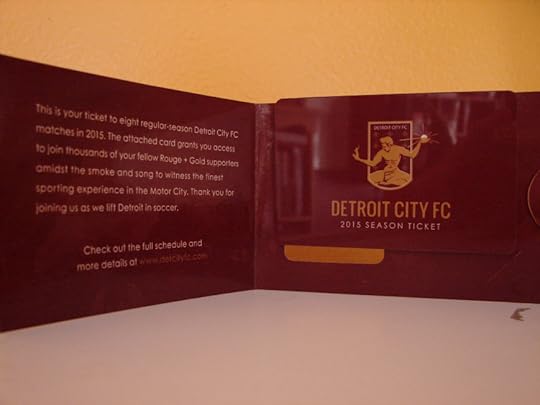 There is good news and bad news.�� The good news is that the team has sold out of season tickets.�� That’s also the bad news for you, if you don’t have a season ticket.
There is good news and bad news.�� The good news is that the team has sold out of season tickets.�� That’s also the bad news for you, if you don’t have a season ticket.
Your best bet would be to plan ahead.�� Either start dating or become friends with a DCFC season ticket holder, who may have an extra seat to spare, or buy your tickets online in advance.���� And when I say in advance, I suggest definitely before game day.�� As I previously noted, the people who arrived with the intent to buy their tickets at the gate for the final game of the season were turned away because the stadium was full.�� Single game tickets go on sale at the DCFC website on March 5th.
Pre-Game
For the hardcore fans, the pre-game begins at Harry’s in Detroit.�� Harry’s is a bar and restaurant which serves up City Red Ale, a Milking It Productions official brew of the Detroit City Football Club.�� There, you will not be able to avoid the rouge and gold, the chanting and drumming of the group known as The Northern Guard Supporters.
At about twenty minutes before game time, the Guard gathers.�� Sgt. Scary leads us….
and then we march to Cass Tech.�� It’s a show of force in support of our team.�� And the neighbors love it.
Before entering the stadium, there is a pause to serenade the visiting team and their non-existent fans….
Once inside the stadium, you have a choice to make.�� Do you sit on the “family-friendly” side or with the Northern Guard Supporters?�� The “family-friendly” side are for those fans who wish to sit and enjoy the match.�� It is traditionally the “home side” of the field because the stands are larger.�� The broadcast booth and the players’ benches are also on that side.�� For the 2012 season, this was where I occupied, and it was fun.
 Or, you can venture into the Supporter’s Side…..
Or, you can venture into the Supporter’s Side…..
 …where you will stand through the match, sing, chant, taunt the opposing team, taunt the referee, get smoke in your eyes and lungs.�� You know…where you will have more fun!
…where you will stand through the match, sing, chant, taunt the opposing team, taunt the referee, get smoke in your eyes and lungs.�� You know…where you will have more fun!
To get a sense of what the experience is like, I wrote about being in this section, with video, HERE.
Intimidated because you might not know the chants?�� Not to worry.�� They can be found at Boys in Rouge blog (a blog you should definitely follow if you are or want to become a DCFC fan).
Et cetera
Yes, this is our soccer team.�� The game on the pitch is what unites us and makes us the passionate fans that we are.





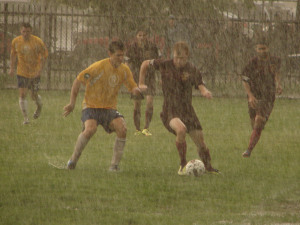

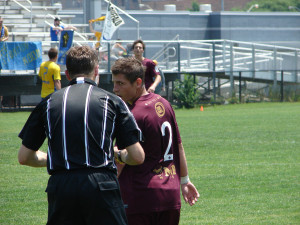





But at a Detroit City FC match, you never know what else may happen.
Tifos have been raised….
Marriages have been performed…
Special jerseys have been worn then auctioned for charitable causes….
The memory of a tragic loss in the soccer community honored….

A halftime performance by the Cass Tech HS Marching Band….
A surprise visit by the Detroit Party Marching Band…
And the blue jeans shorts canon.
There you have it.�� Anyone can have fun at a Detroit City FC match (unless you’re a player, coach, or fan of the visiting team who usually leave filled with envy and defeat).�� Hopefully, this guide has provided you with what you need to maximize your level of fun, after which you will be one of the many passionately feeling, “City Til I Die!”
The atmosphere created by the Northern Guard is so contagious that even the team joins in!


February 26, 2015
Book review: Europa Editions
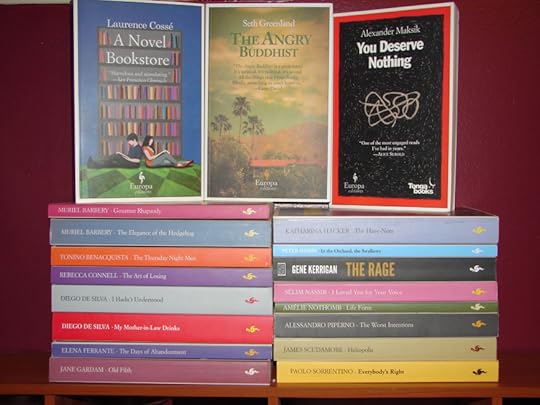 In November, 2013, I was browsing the shelves of Brilliant Books in Traverse City, MI.�� There was a stand-alone shelf promoting the books from a single publisher – Europa Editions.
In November, 2013, I was browsing the shelves of Brilliant Books in Traverse City, MI.�� There was a stand-alone shelf promoting the books from a single publisher – Europa Editions.
According to the company website, Europa Editions was founded in 2005 and has published books by authors from twenty-six different countries, making it a leading publisher of international fiction.�� I believe their most popular title is The Elegance of the Hedgehog by French novelist Muriel Barbery, having spent over a year on the New York Times bestseller list.
As I perused the shelf, one title caught my eye.�� A Novel Bookstore by French writer, Laurence Coss��.�� Usually, when I purchase a book, it is not the next book I read.�� However, while in Traverse City, I set aside the short story collection I was into after sampling the first chapter.�� Then the second.�� Then it became the oddity, violating my habit of reading it almost immediately after purchasing it.
A wealthy married woman meets a single bibliophile in Switzerland and they scheme the idea of The Good Novel Bookstore ��� a book store that stocks only good novels. The store’s inventory was selected from the list of the top 600 novels chosen by eight different writers/readers/book lovers. The eight formed a secret committee; no one outside the owners knew who they were. The store opens to rave reviews, and, simultaneously, harsh criticism.
The novel begins as a mystery, as three of the secret members of the committee experience threats to their physical well-being, with the aggressors signaling that they know about their involvement with The Good Novel Bookstore. The mystery drives the plot, and the real story is the awkward love triangle of Francesca, the wealthy woman in a dismal marriage; Ivan, the bookseller who feels unable to maintain love; and Anis, the much younger love interest of Ivan.
After enjoying this novel, I’ve sought other Europa Editions books.�� The next novel to catch my attention I found at Literati Bookstore in Ann Arbor, titled The Angry Buddhist by American writer Seth Greenland.
The Angry Buddhist is a tale of the cold heart of American politics and the fiery heat of sex and anger. It���s almost election day, and Randy Duke���s re-election race against the attractive Mary Swain. But there is scandal to cover up regarding Randy���s wife, Kendra, who had an affair with their daughter���s tennis instructor, Nadine. Randy has other issues with his two brothers ��� Jimmy (the “angry Buddhist”) and Dale ��� that are both political assets and liabilities to his campaign. Dale is a felon released on parole (thanks to Randy���s influence) in time for the election. Jimmy was discharged from his employment with the police department after failing to put down a dog as ordered by Police Chief ���Hard���. Hard is in Mary Swain���s camp, and no matter how much he fantasizes, she is beyond his reach. So he cheats on his wife, Vonda Jean, with, guess who, Nadine. Nadine ends up being murdered and Jimmy sticks his nose into the investigation and learns about his sister-in-law���s affair with the deceased.
I thought this was a well written, well conceived book. Though the “Angry Buddhist” was not the protagonist (there didn���t seem to be a major protagonist, but rather a group of characters with different and conflicting motives), Jimmy���s perspective and challenge with dealing with anger was interesting.
Recently, I finished reading You Deserve Nothing by American writer Alexander Maksik, which I found at Dawn Treader Used Books in Ann Arbor.�� This is a story about a teacher in Paris and two students, both of whom love him. One, Marie, is consumed with romantic and sexual love; the other, Gilead, is a young man who respects the man, viewing him as a role model.�� Though the ending was predictable, the way the author weaved the POV���s moved the story along nicely.
You may think readers simply follow specific authors.�� In this case, I have been impressed by the publisher and the authors and novels it publishes.�� As you can see by the stack in the photograph, I have many more Europa Editions to read.�� Each of these titles have interesting premises that have caught my attention, much like the three I’ve read thus far.�� The Elegance of the Hedgehog is high on my list, however I believe the next Europa Editions novels I want to read are the two by Diego De Silva; I Hadn’t Understood and My Mother-in-Law Drinks.�� They both feature Vincenzo Malinconico, who “is a wildly unsuccessful lawyer who spends most of his time at the office trying to look busy.�� His wife has left him.�� His teenage children worry him to death.�� And he suffers from a chronic inability to control his sentence structure.”�� With a blurb like that, how can I resist?
Then again, there’s The Thursday Night Men by Tonino Benacquista, about a group of men who meet in random locations in Paris every Thursday night at seven o’clock, to support each other on the issue that unites them:�� heartache with women.
Or there’s…..
Damn.�� So much savory goodness to choose from.

February 20, 2015
Vinyl memories #3 – The War of the Worlds
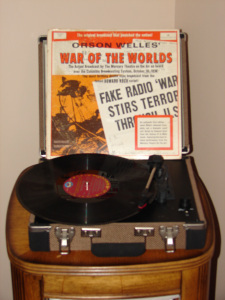
I had written previously about my grandparents and father who grew up on old-time radio shows as the source of their entertainment.�� This record of Orson Welles’ adaptation of H.G. Wells’��War of the Worlds was another that had been passed on to me because I enjoyed listening to it so much whenever I visited.
On October 30, 1938, Orson Welles played the ultimate Devil’s Night prank on America with this adaptation.�� Neither television nor the internet existed back then, so it was the radio that connected people to the broader world than their communities.�� News, sports, comedy, suspense, and music emerged from this new magical box which engaged the theater of the mind.�� Welles, with script writer Howard Koch, chose to create a version of Wells’ classic that came across as if it were actually happening.�� A musical program interrupted by breaking news reports of unusual gas explosions on the planet Mars.�� The music continues, then a new update about something crashing to the earth near Princeton, New Jersey.�� The music returns, then a cut back to the site where a flying saucer had landed, its pilot emerging from it and firing a heat ray at the witnesses, cutting the reporter’s commentary and connection to instant silence.�� The radio station is then taken over by the government for use of a coordinated effort to put down the invasion.�� Act One does not end well for us Earthlings.�� In Act Two, Welles, who is playing the character of Professor Richard Pearson, an astronomer from the observatory at Princeton University, narrates a monologue of what he, as one of humanity’s last survivors, witnesses.
Act One was so realistic it created a panic in the country.�� The back of the album provides samples of Associate Press reports such as:
Pittsburgh – A man returned home in the midst of the broadcast and found his wife with a bottle of poison in her hand, screaming, “I’d rather die this way than like that.”
Indianapolis – A woman ran into a church screaming:�� “New York destroyed; it’s the end of the world.�� You might as well go home and die.�� I just heard it on the radio.”�� Services were dismissed immediately.
The video below is a BBC interview of Orson Welles and some of the after-effects he experienced due to his dramatic program.
As a kid, first hearing it on a record album, it was thrilling.�� Unlike the stories portrayed on old time radio, it was intentional on the part of Welles and Koch to present the story in a realistic way.�� The second act reveals its fictional nature with Welles’ monologue, but by then, the monster was loose on the public, and hysteria commenced.
This is a masterpiece of horror.�� It didn’t rely on blood and gore and sudden shocks to create fear.�� It was a slow and subtle build up to the end of the world as it was happening at a particular place, with the belief that the martians would soon appear in your town, and brought to you through the most intimate and powerful media of the time.
As you watch the BBC interview, at the end of it Welles shares that he had intended to provoke Americans this way.�� The media holds power.�� The internet, television, and back then, radio, has the power to sway our perception of reality.�� In the video Orson Welles confesses that this was his attempt to shake Americans into not believing everything heard on this new, magical box called the radio.
This message is relevant today.�� Just because a story is on the news or on a news commentary program on television or radio, or reported on a website, doesn’t mean it’s true.�� It is being presented for some reason and from a viewpoint.�� Question it.
You may wonder how people back on October 30, 1938, could have fallen for a story about a martian invasion.�� How many irrational beliefs have you encountered that people profess because they read it on the internet or saw it on TV?�� Weapons of Mass Destruction in Iraq?�� Kenyon-born United States presidents?�� The Newtown massacre as a hoax?�� Climate change deniers?�� Creationism as science?�� The list goes on.
When it comes to things reported in the media, trust little, question a lot.
I didn’t realize how early in my life skepticism of the media had originated until I listened to this album again.

February 18, 2015
Ten influential Buddhist books
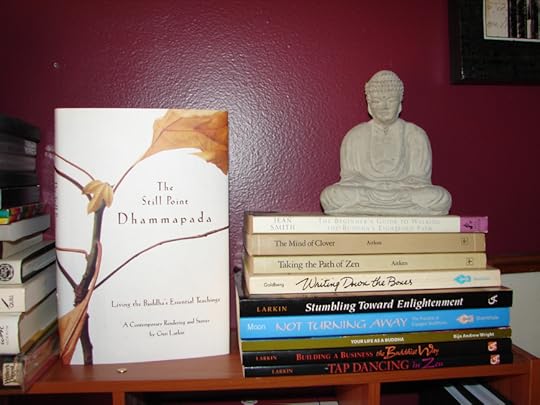
The editors of Shambhala Sun recently listed the ten dharma books every Buddhist should have in their library (and I would assume have read at least once).�� Two of them (When Things Fall Apart by Pema Chodron and Zen Mind, Beginner’s Mind by Shunryu Suzuki) are in my library and I certainly would recommend them.�� With only 20% of Shambhala Sun’s editors’ recommendations, I thought I’d examine the ten dharma books that have influenced me.�� In chronological order, they are as follows:
1. ��Writing Down the Bones by Natalie Goldberg
This is not a Buddhist book, per se, but a classic for writers about writing.�� Goldberg is a Zen Buddhist, applying right off the bat the approach of the beginner’s mind.�� Through this book I discovered Zen.
2.�� Taking the Path of Zen by Robert Aitken
This was the first book on Buddhism I read back in the 1980’s which covered the basics.
3.�� The Mind of Clover:�� Essays in Buddhist Ethics by Robert Aitken
After reading Taking the Path of Zen, this came as a natural follow-up, as Roshi Aitken delved deeper into the precepts and their meanings.
4.�� The Beginner’s Guide to Walking the Buddha’s Eightfold Path by Jean Smith.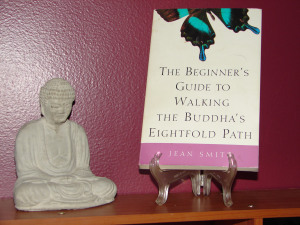
Looking for a clear definition of The Eightfold Path, I found Jean Smith’s book to be a helpful examination of each step of the path.
5.�� Stumbling Toward Enlightenment by Geri Larkin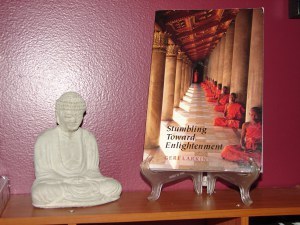
In the fall of 2002, I discovered Still Point Zen Buddhist Temple in Detroit.�� It was the first opportunity to practice with others and with a guiding teacher.�� P’arang Geri Larkin was not only the guiding teacher, but also the founder of Still Point.�� Prior to Still Point’s birth, P’arang gave dharma talks at the Ann Arbor Buddhist Temple and the Chicago Zen Buddhist Temple, and wrote a few books on Zen.�� P’arang’s practical, accessible, and gritty approach is what grounded the roots of my practice.�� This book is another excellent, accessible introduction to the practice of Zen.
6.�� Tap Dancing in Zen by Geri Larkin
A collection of P’arang’s teachings to help your practice every day.
7.�� Building a Business the Buddhist Way by Geri Larkin
Prior to becoming a guiding teacher, P’arang was in the “real world” of business.�� A management consultant for Deloitte & Touche, her experience in the corporate world and her Buddhist studies combine in this guide on how to create a right livelihood business (Right Livelihood is one of the steps on The Eightfold Path).�� I found this book helpful both in creating the no-sweatshop clothing store I owned for eighteen months, and my law practice.�� A poster inspired by it hangs on my office wall.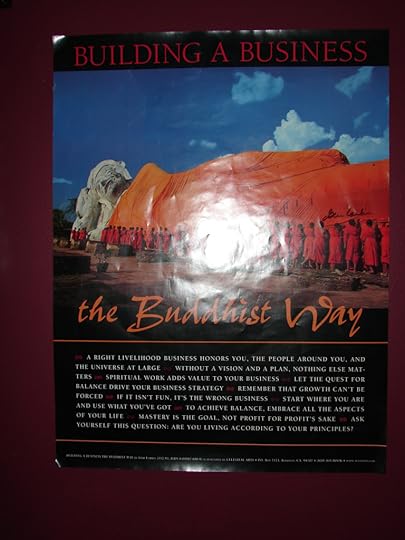 8.�� The Still Point Dhammapada by Geri Larkin
8.�� The Still Point Dhammapada by Geri Larkin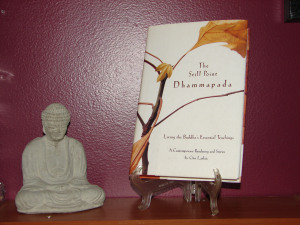
The Dhammapada is a collection of over four hundred verses that Buddha is said to have spoken.�� Its a text lush with wisdom.�� P’arang, from her experience at Still Point, translates The Dhammapada with application and examples of living in today’s world, in the early years of this century in Detroit (The book was published in 2003).
Yes, P’arang Geri Larkin’s writings have been a significant influence on me, but they pale in comparison to Still Point Buddhist Temple.�� My practice has improved significantly by having a place to practice and a guiding teacher.�� My practice deepens moreso by sitting, chanting, and listening to the dharma talk on a Sunday morning than by reading a shelf full of books. 9.�� Not Turning Away: The Practice of Engaged Buddhism edited by Susan Moon.
9.�� Not Turning Away: The Practice of Engaged Buddhism edited by Susan Moon.
Turning Wheel: The Journal of the Buddhist Peace Fellowship takes Buddhism into a social practice.�� This anthology of essays, as Susan Moon writes in the Preface, are “accounts of how ordinary people bring together in their own lives their dharma practice and their work for peace and justice.”�� It’s about putting spiritual practice to work on a personal, national, and global level.
10.�� Your Life as a Buddha: Zen Faith for the 21st Century by Bija Andrew Wright
Zen Buddhist teacher, Bija Andrew Wright, takes the Lotus Sutra, one of the most important and influential scriptures in Buddhism and interprets it as an instruction manual on how the lay person can be a Buddha in the 21st Century.�� Bija was ordained under P’arang Geri Larkin at Still Point.

February 12, 2015
Vinyl Memories #2 – Remember the Golden Days of Radio
 The simple pleasure of the phonograph was introduced to me through my parents and grandparents.�� My maternal grandparents – Grandpa and Grandma Becoskey – had a cabinet stereo with phonograph and radio in their front room next to the television set.�� I don’t recall the music they listened to, but my aunt lived with them and I remember her playing a lot of Tom Jones.�� The appreciation of sound entertainment was strongly fostered by my father’s side of the family.
The simple pleasure of the phonograph was introduced to me through my parents and grandparents.�� My maternal grandparents – Grandpa and Grandma Becoskey – had a cabinet stereo with phonograph and radio in their front room next to the television set.�� I don’t recall the music they listened to, but my aunt lived with them and I remember her playing a lot of Tom Jones.�� The appreciation of sound entertainment was strongly fostered by my father’s side of the family.
In the 1940’s, during his adolescence, my father expressed an interest in playing the banjo.�� My grandfather spent $5 for a four-string banjo and paid for private lessons.�� When my dad was around thirteen years old, Grandpa Kitchen found a guy in Highland Park who was selling a used four-string Gibson tenor banjo for $50 and bought it for him.�� He still has it today.�� Then, my father and his sister (Aunt Shirley) would perform weekly on WEXL-AM out of Royal Oak.�� The station was owned by Jacob B. Sparks and located in the Sparks Funeral Home.�� A small chapel in the funeral home was used as the studio, and my dad on his banjo and my aunt on her Rickenbacker Hawaiian Guitar would be on the air Sunday nights for almost three years in the late 1940’s.
My grandmother’s sister – Aunt Menda – had a Wilcox-Gay recording device and had recorded them on 78’s.�� The device had a radio and two arms for the phonograph.�� One arm was used to play records in the standard way, moving inward to the center of the record.�� The other arm would be placed on the inside, and as it recorded onto a blank disk, it would move outward.�� She would record my dad and aunt off the radio with the device.�� While going through the 78’s within Aunt Menda’s Victrola, I discovered only one family recording: my Aunt Menda’s wedding.�� The ceremony included a solo sung by my very young father.
My grandfather eventually owned a Wilcox-Gay and a recording was made when my sister and I were young.�� Very young.�� There was an infant crying in it, which had to be my sister as she’s the youngest of the Kitchen grandparents’ grandchildren,�� which put me between two and three years old.�� It was a classic.�� I sung the Batman television theme song, in my own style.�� Instead of the “na na na na na” lyrics, I improvised with “boody boody boody boody.”�� I’d love to share it but alas, it lies in a landfill today.
Both my grandparents and my dad were of the era of radio entertainment.�� We were brought up on not only television, but the wonderful world of the theater of the mind.�� Not only the shows of the past.�� I remember listening to the CBS Radio Mystery Theater which aired, I believe, on WWJ-AM here in Detroit on week nights during the 1970’s.
Remember the Golden Days of Radio: Volume 2, presented by the Longines Symphonette Society, was a sampling of how important radio was as the entertainment medium before television.�� My grandparents had this album, and it takes me back to their home in Garden City, Michigan.�� I wanted to listen to this album every time I was over there because an eight minute track of The Shadow was chilling and captivating.
Take a moment, if you will.�� Turn off the lights.�� Don’t watch the video, but listen to it.�� Put yourself into this excerpt.�� When I listened to this as a kid, it was frightening, but cool.�� Listening to it now, I still get the chills of the scene depicted, and appreciate the writing and performances by the actors.
Try to listen to this on a computer – laptop or desktop.�� I imagine the effect is somewhat lost if you play this through a phone, or something with low-quality speakers.
Indulge yourself.
Cool, eh?
The only thing scarier than listening to this album at my grandparents’ house was playing Pinochle with my grandmother and her sisters.�� Let me tell you.�� These ladies, who loved their church and loved their religious hymns and gospel preachers, who were the nicest women you’d ever meet, were feisty competitors at the card table.�� Make a mistake, and not even The Shadow could save you from their chastising!�� But it was fun and made me the competitor I am today.
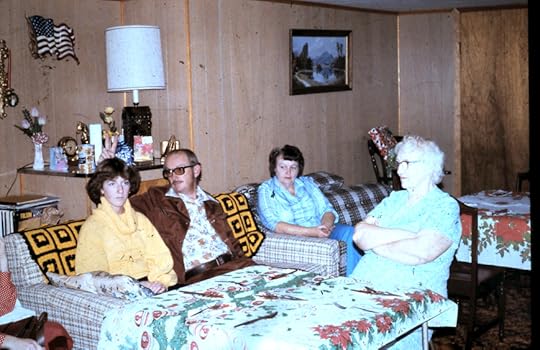
My Grandparents’ basement. From Left to right: My sister, Marie; Dad, Lester; Aunt Shirley; Grandma Kitchen.
Jack Benny and Frank Knight narrate this album, talking about the various shows and events.�� The Shadow excerpt is the longest track focusing on a single show.
The tradition was passed on to the fourth generation by my dad.�� You can ask my son or daughter who Edgar Bergan, Charlie McCarthy and Mortimer Snerd are, or Fibber McGee and Molly, or, of course, Jack Benny, and they’ll be able to tell you.
Old time radio.�� The entertainment that brought families together almost a century ago, runs through four generations of Kitchens.
Side A: RADIO ADVENTURE AND MYSTERY DRAMA
Jack Armstrong, All American Boy
The Lone Ranger
Terry and The Pirates
Famous Jury Trials
Dangerous Assignment
Mr. Keene, Tracer of Lost Persons
Gang Busters
The Shadow
Side B: THE CLASSIC RADIO NEWS BROADCASTS
1st Presidential election broadcast returns
President Coolidge and Charles Lindberg before Congress
Billy Sunday opposes repeal of prohibition
FDR is inaugurated; Adolph Hitler; Edwin C. Hill
The Greatest “Eye-Witness” report in history: The Von Hindenburg crashes in flames.

February 7, 2015
Vinyl memories #1
According to a recent article out of the UK, low-tech living is making a comeback.�� Books, records, typewriters, flip-phones and Polaroids are technologies that just won’t go away.
I consider myself lucky to be in my early fifties at this time.�� I had the benefit of living in the era when these technologies were used every day.�� Books will always exist in my world because I do not find comfort in reading on a screen.�� I have both a manual and electric typewriter.�� The electric I still use to occasionally address envelopes (yes, I pay bills with handwritten checks and correspond through the US mail).�� I’m writing the first draft of a long-term project on the electric typewriter because it both slows me down and puts me in the frame of mind of writing in a different era.�� I have a landline telephone and my cell phone is a flip phone.
But I won’t go to the Polaroid.�� Or back to the 35mm SLR camera.�� I do love my Sony digital camera.�� It saves a lot of money on film and developing.
Recently, I returned to vinyl.�� In the summer of 2014, my Aunt Marlene and Uncle Bob moved to Portland, Oregon.�� They had my Aunt Amanda’s (Aunt Menda, we called her) Victrola in their basement.�� Having moved from an apartment to a house just weeks before, they offered it to me before donating it.�� Then, I purchased a Crosley turntable from my friends at Weirdsville Records/Paperback Writer Books.�� I’ve unpacked the stash of my few remaining records from the days of 33 1/3 rpm musical entertainment, as well as the newest editions of vintage vinyl to my collection, and have them all stacked on my desk in the basement.�� Occasionally before or after dinner, I’ve descended into yesteryear to unwind from the day of writing or court (or both), to spin one of the records.�� The basement transforms into a dance hall of memories, swaying me into another era.
My intent here is not to review these records.�� Music isn’t my forte.�� Sure, I was in the band during my middle and high school years, but it was under duress.�� For me, music is the trigger of memory and fun.�� I’ve been partial to soundracks over the years, because they invoke the memory of the scene of the movie.�� And thumbing through the albums, fun is at the forefront.�� The Monkees.�� ShaNaNa.�� Blues Brothers.�� Madness.�� Doug and the Slugs.
Some artists that the population love, I just can’t listen to.�� And some artists that the population ignore are those I prefer.�� Can’t explain it.�� Maybe during these vinyl memories I (or you) will.�� Enlighten me if you do.
The Design Records album above is The Super Record of Super Heroes Played by the Super Dupers.�� I’ve had this album since I was a kid, and listening to it brought back the groovy time of suburban adolescence in the 1970’s.
The 70’s.�� I was eight years old entering it and graduated high school June of 1980.�� It was a time of riding my bike up to Wiltse’s Pharmacy on Main Street in Plymouth, or all the way out to the Beyer/Rexall Drug Store on Ann Arbor Road and the Little Professor Book Store in the strip mall at Sheldon and Ann Arbor Road, to see the new comic books that were for sale.�� It was a time of weekly car rides out to C.C’s – Classic Comics and Movies – in Farmington Hills, to descend into the cellar of four-color fantasy.�� Also, baseball and hockey cards were collected, and the discovery of dishonesty from some friends who, when trading cards with them, stole from me.�� It was the era of the Mego action figures and the friendship of a kid who visited his grandmother across the street, who was the only other person I knew that shared these interests.
A time of innocence.�� Dreams of being a hero despite the unathletic, scrawny frame.�� This is the perfect album to begin with.
The tunes on this album were not the television theme songs, but arrangements based on the characters.�� Funky and fun, replaying it brings a smile.
“Captain Marvel Jones, He’s the Southern Super Man.(with a real Ray Stevens feel to it)”
“Who knows what evil lurks in the dark of night?�� Ah, well, ah, the Shadow do.”
“Here he comes,
Flash Gordon,
All the girls love Flash Gordon,
But there’s no time for love and no time for courting
cuz Flash Gordon
has more important
things to do.”
The March of Tarzan, with the exception of the classic Tarzan yell, is instrumental with guitar and organ.�� The Green Hornet is an odd variation in piano and 70’s techno instead of the powerful trilling trumpet.
Yeah, I’ll be enjoying this one again and again.
Side One:
Batman and Robin
The Phantom
The Shadow
Flash Gordon
Side Two:
March of Tarzan
Captain Marvel Jones
Mickey Mouse March
The Green Hornet
I found YouTube clips of some of the tunes.�� Here’s one of them.

February 4, 2015
Upcoming Book Signing Event – Plymouth MI
I will be at the Plymouth District Library’s Local Author Fair on Saturday, March 28, 2015.
Plymouth District Library
223 South Main
Plymouth, MI�� 48170
Saturday, March 28, 2015
1:00 PM – 3:00 PM


